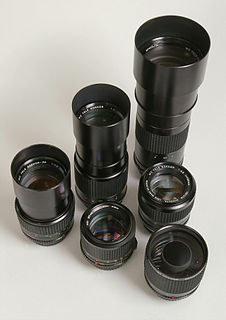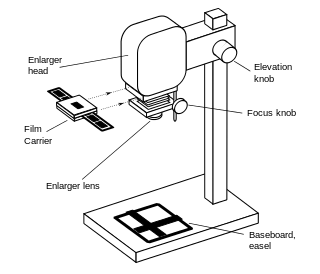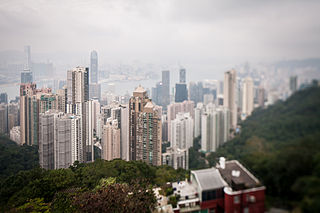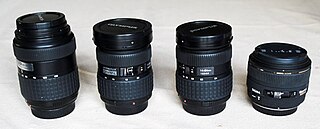
A single-lens reflex camera (SLR) is a camera that typically uses a mirror and prism system that permits the photographer to view through the lens and see exactly what will be captured. With twin lens reflex and rangefinder cameras, the viewed image could be significantly different from the final image. When the shutter button is pressed on most SLRs, the mirror flips out of the light path, allowing light to pass through to the light receptor and the image to be captured.

A camera is an optical instrument that captures a visual image. At a basic level, cameras consist of sealed boxes with a small hole that allows light through to capture an image on a light-sensitive surface. Cameras have various mechanisms to control how the light falls onto the light-sensitive surface. Lenses focus the light entering the camera. The aperture can be narrowed or widened. A shutter mechanism determines the amount of time the photosensitive surface is exposed to light.

A rangefinder camera is a camera fitted with a rangefinder, typically a split-image rangefinder: a range-finding focusing mechanism allowing the photographer to measure the subject distance and take photographs that are in sharp focus. Most varieties of rangefinder show two images of the same subject, one of which moves when a calibrated wheel is turned; when the two images coincide and fuse into one, the distance can be read off the wheel. Older, non-coupled rangefinder cameras display the focusing distance and require the photographer to transfer the value to the lens focus ring; cameras without built-in rangefinders could have an external rangefinder fitted into the accessory shoe. Earlier cameras of this type had separate viewfinder and rangefinder windows; later the rangefinder was incorporated into the viewfinder. More modern designs have rangefinders coupled to the focusing mechanism so that the lens is focused correctly when the rangefinder images fuse; compare with the focusing screen in non-autofocus SLRs.

A pinhole camera is a simple camera without a lens but with a tiny aperture —effectively a light-proof box with a small hole in one side. Light from a scene passes through the aperture and projects an inverted image on the opposite side of the box, which is known as the camera obscura effect. The size of the images depends on the distance between the object and the pinhole.

A view camera is a large-format camera in which the lens forms an inverted image on a ground glass screen directly at the plane of the film. The image is viewed and then the glass screen is removed and the film inserted in its place, and thus the film is exposed to exactly the same image as was seen on the screen.

A twin-lens reflex camera (TLR) is a type of camera with two objective lenses of the same focal length. One of the lenses is the photographic objective or "taking lens", while the other is used for the viewfinder system, which is usually viewed from above at waist level.

A camera lens is an optical lens or assembly of lenses used in conjunction with a camera body and mechanism to make images of objects either on photographic film or on other media capable of storing an image chemically or electronically.

In photography and cinematography, a wide-angle lens refers to a lens whose focal length is substantially smaller than the focal length of a normal lens for a given film plane. This type of lens allows more of the scene to be included in the photograph, which is useful in architectural, interior and landscape photography where the photographer may not be able to move farther from the scene to photograph it.

A telephoto lens, in photography and cinematography, is a specific type of a long-focus lens in which the physical length of the lens is shorter than the focal length. This is achieved by incorporating a special lens group known as a telephoto group that extends the light path to create a long-focus lens in a much shorter overall design. The angle of view and other effects of long-focus lenses are the same for telephoto lenses of the same specified focal length. Long-focal-length lenses are often informally referred to as telephoto lenses although this is technically incorrect: a telephoto lens specifically incorporates the telephoto group.

An enlarger is a specialized transparency projector used to produce photographic prints from film or glass negatives, or from transparencies.

An autofocus optical system uses a sensor, a control system and a motor to focus on an automatically or manually selected point or area. An electronic rangefinder has a display instead of the motor; the adjustment of the optical system has to be done manually until indication. Autofocus methods are distinguished by their type as being either active, passive or hybrid variants.

In photography, a viewfinder is what the photographer looks through to compose, and, in many cases, to focus the picture. Most viewfinders are separate, and suffer parallax, while the single-lens reflex camera lets the viewfinder use the main optical system. Viewfinders are used in many cameras of different types: still and movie, film, analog and digital. A zoom camera usually zooms its finder in sync with its lens, one exception being rangefinder cameras.
In photography, through-the-lens (TTL) metering refers to a feature of cameras whereby the intensity of light reflected from the scene is measured through the lens; as opposed to using a separate metering window or external hand-held light meter. In some cameras various TTL metering modes can be selected. This information can then be used to set the optimal film or image sensor exposure, it can also be used to control the amount of light emitted by a flash unit connected to the camera.

Tilt–shift photography is the use of camera movements that change the orientation or position of the lens with respect to the film or image sensor on cameras.

A photographic lens for which the focus is not adjustable is called a fixed-focus lens or sometimes focus-free. The focus is set at the time of lens design, and remains fixed. It is usually set to the hyperfocal distance, so that the depth of field ranges all the way down from half that distance to infinity, which is acceptable for most cameras used for capturing images of humans or objects larger than a meter.

Live preview is a feature that allows a digital camera's display screen to be used as a viewfinder. This provides a means of previewing framing and other exposure before taking the photograph. In most such cameras, the preview is generated by means of continuously and directly projecting the image formed by the lens onto the main image sensor. This in turn feeds the electronic screen with the live preview image. The electronic screen can be either a liquid crystal display (LCD) or an electronic viewfinder (EVF).

Tilted plane photography is a method of employing focus as a descriptive, narrative or symbolic artistic device. It is distinct from the more simple uses of selective focus which highlight or emphasise a single point in an image, create an atmospheric bokeh, or miniaturise an obliquely-viewed landscape. In this method the photographer is consciously using the camera to focus on several points in the image at once while de-focussing others, thus making conceptual connections between these points.

This article is about photographic lenses for single-lens reflex film cameras (SLRs) and digital single-lens reflex cameras (DSLRs). Emphasis is on modern lenses for 35 mm film SLRs and for DSLRs with sensor sizes less than or equal to 35 mm ("full-frame").
The design of photographic lenses for use in still or cine cameras is intended to produce a lens that yields the most acceptable rendition of the subject being photographed within a range of constraints that include cost, weight and materials. For many other optical devices such as telescopes, microscopes and theodolites where the visual image is observed but often not recorded the design can often be significantly simpler than is the case in a camera where every image is captured on film or image sensor and can be subject to detailed scrutiny at a later stage. Photographic lenses also include those used in enlargers and projectors.

Afocal photography, also called afocal imaging or afocal projection is a method of photography where the camera with its lens attached is mounted over the eyepiece of another image forming system such as an optical telescope or optical microscope, with the camera lens taking the place of the human eye.
















